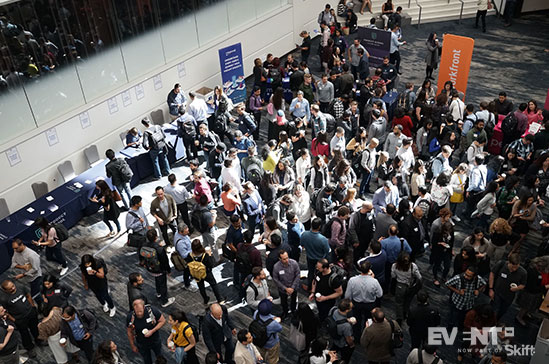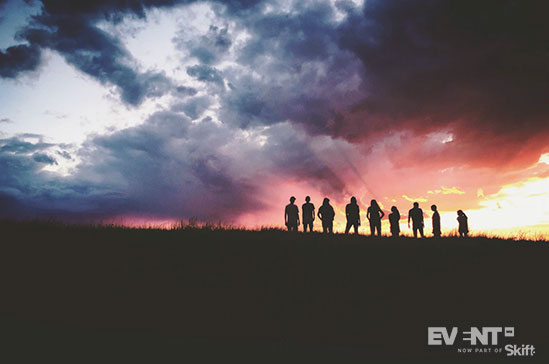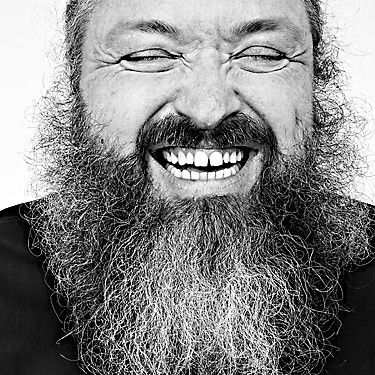Skift Take
Trade shows have the biggest opportunity in the event industry right now. They are the perfect recipient for all that extra budget coming from marketing companies. Still, they get a bad rap. Are they just dying or are we just witnessing a powerful transition?
Last week, I had a chance to attend Expo! Expo!, IAEE’s cleverly named expo for the events industry – which attracted north of 2,000 attendees this year.
I walk into the show with one idea in mind. What does the future of trade shows look like? What are the suppliers offering? What are experts saying?
The Short Version
Overall, my impression was mixed.
There were definitely some highlights, and I’ll get to those in a minute.
The general impression I got from everyone I spoke to is that the industry is changing, and we’re entering a period where the ability to adapt and innovate is going to separate the wheat from the chaff across verticals.
The consensus seems to be that traditional trade show business models that prize trade show real-estate don’t reflect the current reality of B2B business in the digital age.
We used to come to these things to discover new business opportunities; now, we can find that information online, and we come to expos looking for face-to-face connections, memorable experiences and co-created learning opportunities.
I did my journalistic thing, had some great conversations, conducted a few interviews, and now I bring you the scoop.
Exhibitors tell a story
There were some strong activations on the exhibition floor, but there seems to be a generational split between suppliers.
It was a relief to see the organizations with an eye on where events are now and where we’re headed in the future, but there were just as many who didn’t seem to get the memo.
-
Everybody seems sold on the value of inclusion, sustainability, new formats…When you meet these folks in real life, in their favorite face-to-face environment, it feels like such online activism ends up being more of a content marketing exercise or a way to get a few likes than reality.
At least for some.
Some suppliers seem to walk the walk; others resort to the usual trade show tactics we have seen since the late 1800s.
I see a generational split that has a lot to say about the future of trade shows.
The Wheat
The ‘walk the walk’ category included forward-thinking suppliers with a pulse on the industry, an awareness of the trends, and (most importantly) attention to experience design.
GES (full disclosure: GES is an EventMB client) was a perfect (and widely retweeted) example of what can happen when you fully embrace the power of storytelling. Their unzipped, superhero-themed booth reinforced a narrative that we all want to be a part of. The message was simple but resonant: “We take care of the logistics at your event, and you become the superhero.”
The exhibit hall is officially open at @IAEE_HQ #expoexpo! Join GES at The Superhero Experience- Booth #725 and discover your extraordinary powers! pic.twitter.com/KAyVTbew20
— GES Global (@GESGlobal) December 4, 2019
I asked GES Chief Marketing Officer Wendy Gibson about the challenges afflicting so many of the lackluster booths on the floor and what you need to do in order to deliver on the promise of a live experience and a solid opportunity for connection at an event like this. The focus, she told me, should be on “interactive, collaborative conversations and the value of face-to-face.”
Other booths were strong on the sustainability and CSR front, advertising and embracing the power of sustainable supplies or destinations.
I was thoroughly impressed by how The New Orleans Company (what a better way to call a DMO!) has partnered with local nonprofits and NGOs like Bethel Colony to donate excess food and prevent waste, and has just named a new director of sustainability and CSR.
Also worth noting: the Los Angeles Convention Centre was promoting its 5G services, and they’re doing their part to bring about the mainstream 5G accessibility we’re all eagerly anticipating (and covering here at EventMB).
The Chaff
While there was a lot to root for on the show floor, there were also a few notable facepalms and eye rolls lurking around the odd corner.
Maybe the old-school booths and passé tactics were not that frequent, but they left a taste in my mouth I didn’t care for. For me, they kind of stuck out.
There must be an adage out there about the propensity to remember the bad.
I noticed a distinct lack of diversity and representation within the audience at some booths, even with some exceptions like Eventray, a tech company based in Puerto Rico with incredibly diverse representation. Kudos to the founders.
-
There were booths, as usual, trying to entice traffic with the promise of free alcohol –
or even worse, converging all the booth marketing messages on Tequila and Whiskey.
The tides are changing. Who comes to a professional event in 2019/2020 and walks through the door like “where’s the bar!?”. This isn’t your cousin’s wedding.
Attendees today are looking for value beyond the chance to get out of the office and party. These events are vehicles for building important professional contacts, for learning from the leaders of the industry. They are rare opportunities to get precious face-time with your peers and make connections that will support and guide you for the rest of your career.
Put the margarita down.
Tech boredom
There is tech stagnation in the industry. Maybe that’s too strong. Let’s be optimists and call it a tech lull. I tweeted about this earlier while doing research for our annual trends update.
As I was reviewing new cool #eventtech tools to update our trends, I found out there are no new cool #eventtech tools. Or close to none.
3 years ago we were submerged by new startups. Things are stalling.
This is a problem for the whole #eventprofs industry.
— Julius Solaris (@tojulius) November 28, 2019
Going around the event’s tech circuit, some folks were doing cool things, but mostly it was a kind of meh.
The event tech industry is hard to break into, and the success of new players will depend on their ability to identify struggles and challenges that sorely need fixing and find creative solutions. It’s about finding unique and unexpected ways to deliver value – not just the usual software that does the usual thing. Yet another event app, yet another EMS.
What The Future Looks Like
Events are increasingly about human connection, about a multi-sensorial interaction that’s simply not happening online.
I had the privilege of speaking to several experts about how they felt about the show and where they thought trade shows and exhibitions were going in the next 10 years.
-
The consensus is that the old model of selling exhibitors on the importance of floor space and shuffling people around the room to talk to as many as possible no longer speaks to what exhibitors need or what the new generation of attendees want.
As Millennials continue to mature into the workforce and displace a percentage of the attendees at these things, expo organizers and the businesses they attract need to shift their tactics to meet a new set of expectations – a desire for experiences and connection, for interactivity and collaboration. They no longer want to be spectators, but participants.
But it’s not just Millennials who are less interested in booth-hopping. I spoke with industry legend Dave Lutz, Managing Director at Velvet Chainsaw Consulting, who rightly pointed out that, for better or for worse, there is still very much an ‘old boy’s club’ of event veterans who manage significant spend and attend these shows largely for the social and interactive experience.
But he’s also conscious of a shift that is largely driven by a new digital B2B model.
“The conversation,” he observed, “has changed from being about trusted marketplaces to identifying trusted platforms.” To survive, according to Lutz, the expo and trade show model itself has to account for how B2B business is changing.
The Key? Event Experience Design
Stealing a moment to speak to a new personal hero of mine, Bruce Mau, Chief Design Officer of Freeman, shared his take on this trend and its effect on trade shows.
The key, according to Mau, is engaging all five senses. “Most shows are designed for the eyeball, but the competitive advantage of live events is an appeal to the rest of your senses. If it’s just the eyeball, I can do it on my computer. If it’s all my senses, I can’t. I can’t have the smell and taste and depth of experience that I can with live using all my senses.”
The point is to take advantage of an opportunity for a deep emotional experience that you can only get from doing something live that you’ll never forget.
Shift to Content and Community
A big part of this shift in from discovery to conversations has to do with a change in the supply and accessibility of content. We no longer have to rely on these shows to find key information. “That old concept of the show was that we had a lock on the information,” Lutz points out. “The only way you could get it was going to the show. That’s over.”
The problem is that the traditional trade show business model leads to an event design that fails on this key deliverable. Kai Hattendorf, Managing Director and CEO of UFI, articulated the problem precisely.
Hattendorf’s view is that the evolution of this industry is inevitably governed by supply and demand, and the demand is clearly shifting.
“The trade show model is a three-pillar structure or triangle: you have trade, you have branding, and you have the content or community part. If you want to balance it on your finger, there is one point where things are going to balance. And this point of balance has shifted from trade to branding for a long time in the 80s and 90s, and through digitization and globalization, it’s changing ever more towards community and content. People need less space to exhibit if they just want to bring people to have conversations, and that’s the biggest threat to the ‘square meter’ model.”
The Events Crucible
We recently produced a research report about how to design experiences that engage higher-level thinking for deeper, more transformative events, and I was curious about how he would square the need for better educational design at events with the pressure to create immersive, transformative environments.
“The biggest issue the industry will have to navigate is the growing convergence of business models between types of events. We no longer have pure play trade shows, conferences, and concerts. Business models are consolidating to some degree. The perception is overlapping and the expectation is changing.”
In short, events today are crucibles where the best elements of different event categories are being extracted, experimented with and merged.

The Synthesis of Digital and Live
To me, Expo! Expo! confirmed that, in this period of experimentation with different event elements, those with their ear to the ground for what works and what doesn’t will make a distinct impression.
Citing the famous trade show comparison, Hattendorf points out that someone stepping out of a TARDIS from 1890 to find themselves on the Expo! Expo! show floor wouldn’t have a problem navigating it. “You will wonder about the strange new app sign and the wonderful new letter in the alphabet. But besides that, nothing will have changed.”
But what would mystify them, he adds, “is the whole digital layer that you have on the very same show floor.”
“The level of technology being woven into the trade show floor, the trade show experience – that’s the new stuff. That’s what takes the show away from this old-fashioned perception and into more collaborative, more data-driven business models.”
Of course, the digital layer extends in many ways beyond the show floor itself. Digital marketing initiatives that begin months before the show influence and feed into the live digital experience. One of the most exciting applications of this layer is in live streaming, which allows the event itself to extend beyond the onsite, in-person experience. It’s all part of what Mau calls a “synthesis of digital and live.”
“What we’re seeing is that kind of migration/evolution/transformation of the experience to a fully synthesized digital-physical live experience. So you get all of the reach of digital but all of the depth of live.”
Building a Community
Extending reach and attracting members is a continual concern for association events like this, which are often at an adaptability disadvantage when competing with more nimble profit-motivated organizations. These days, it seems like you don’t even need to be a planner to throw a successful event. With all these influencers doing their own events and shows, I wanted to know if we as an industry were missing out on an opportunity to capitalize on that business.
“The ‘accidental organizers’ are an amazing opportunity to learn,” said Hattendorf. “They don’t set out to run an event; they set out to build a community.” Many experienced organizers are looking at the phenomenon to learn and challenge their way of thinking.
The new community-oriented model they seem to be using could hold the secret to better member retention, engagement, and revenue.
“If you can monetize a community – not just once a year at a trade show, but turn that ‘few days in the year on a show floor’ model and into a 365-day, 24-hour, 24/7 community exercise – you’ll probably have more money afterwards.”

With Digital Comes Data
Fundamentally, it boils down to a question of ‘if you can’t beat ‘em, join ‘em.’ Community building at unprecedented speed is a manifestation of the same digital age factors that fuel the Millennial desire to connect both in and out of the event space.
Perhaps the difference is that these ‘accidental planners’ and their sold-out shows start with digital, and leverage their success online to swell the ranks for offline experiences that promise to enhance a strong existing connection. Their de facto members are loyal because they’ve been able to co-create the experience from the beginning.
Traditional events, on the other hand, are adding a digital layer to a model that still commoditizes physical space in order to bring the sense of community up to a competitive standard, and they haven’t quite figured it out yet.
When it comes to implementing the digital layer well, Hattendorf presented me with two keys to doing this well:
1) securing the right tech to produce the right data, which also benefits exhibitors, and
2) using that data to prove the ROI for their event. “This kind of touchy-feely ‘I met a lot of people and I got drunk and, hey, now I have a buddy I can call’ is no longer going to cut it.
I’ve been telling people to prepare themselves for the onset of a data-governed event ecosystem until I’m blue in the face, but according to our latest research on the subject, only 48% of planners rely on event tech to deliver actionable data. The rest either think data is a ‘nice to have’, don’t care about it or don’t even bother collecting it.
As expectations for onsite event technology evolve, the ability to generate and analyze data on the spot will enable planners and exhibitors alike to be more responsive onsite, and to secure a better ROI.
IN CONCLUSION
Can trade shows rely just on selling space as a viable business model for the future? The answer is a loud and resounding NO.
Do we need to wait for trade shows to find out what’s new? That would be just silly. It’s unrealistic in the digital age to expect to discover new products exclusively in person.
Do trade shows have the same impact on the buyer decision-making process they used to have? Of course not. The web offers comparison sites, reviews, videos. It’s a million times better for making informed decisions.
Are trade shows done then? Absolutely not. They have transitioned to spaces where (digital) communities get together. A true live brand experience.
We are just witnessing the beginning of a new era for trade shows. Where the shouting and booth babes are replaced by functional spaces for connection, where brands and customers can have focused conversations.
This need is very strong with younger generations, where the depersonalization of digital is driving masses to live experiences.
The question is, will the trade show industry be able to accept the challenge and change? We will see what the next decade brings.
This article includes contributions by EventMB’s deputy editor, Dylan Monorchio









